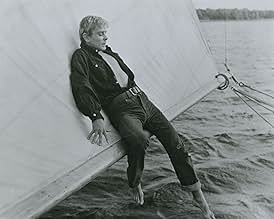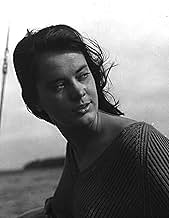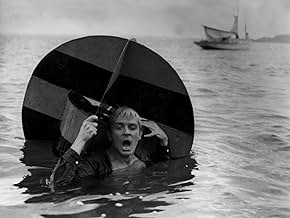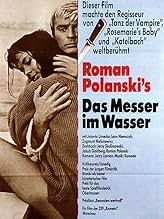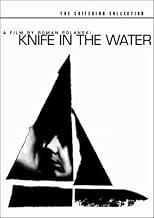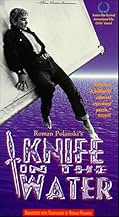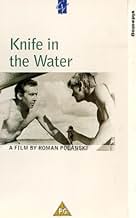AVALIAÇÃO DA IMDb
7,4/10
24 mil
SUA AVALIAÇÃO
Adicionar um enredo no seu idiomaA couple pick up a hitchhiker on the way to their yacht. The husband invites the young man to come along for their day's sailing. As the voyage progresses, the antagonism between the two men... Ler tudoA couple pick up a hitchhiker on the way to their yacht. The husband invites the young man to come along for their day's sailing. As the voyage progresses, the antagonism between the two men grows. A violent confrontation is inevitable.A couple pick up a hitchhiker on the way to their yacht. The husband invites the young man to come along for their day's sailing. As the voyage progresses, the antagonism between the two men grows. A violent confrontation is inevitable.
- Indicado a 1 Oscar
- 1 vitória e 2 indicações no total
Anna Ciepielewska
- Krystyna
- (narração)
- (não creditado)
Roman Polanski
- Young Man
- (narração)
- (não creditado)
Enredo
Você sabia?
- CuriosidadesThe first scene in the film shows Andrzej and Krystyna driving a car. As shooting from the platform in front of the car was not yet available, the crew was tied to the car, standing on its mask. To get the proper light effects, they held a blanket with a small hole for the camera. Leon Niemczyk (Andrzej) was really driving this car quite fast (this was crucial to this scene), but he couldn't see anything. He drove the car using the tops of the trees to imagine where the road is.
- Erros de gravaçãoWhen the young boy is trying to stabilize the Christine by hanging off its side, the railing of the camera boat can be seen in the lower left-hand corner of the screen.
- ConexõesEdited into Spisok korabley (2008)
Avaliação em destaque
Roman Polanski's first full length feature is a simple, minimalist piece filled with male posturing, dead end situations, claustrophobic environments and eerie calm. This is part of Polanski's art house beginnings, but many of its themes and much of its style would be carried through to his later, more accessible work.
Like many a Polanski picture, Knife in the Water shows us men competing over a woman. Typically however this is to the end of making the men look ridiculous rather than objectifying the woman. Here the competition is the central theme, and the bulk of the film is basically a series of set pieces in which the middle-aged husband and the young hitchhiker attempt to outdo each other or show the other up. This drama is concentrated and focused by having only the three characters, and confining the action almost entirely to one location. This kind of minimalism is a safe, simple way to make a straightforward, uncluttered story a good strategy for an up and coming director but it's a lot harder to make a really great picture out of such simple elements, and the young Polanski does fall somewhat short here.
What Polanski does have is his natural talent and feel for cinematic form. His sense of rhythm was evident from his earliest shorts, and by this point he had clearly settled upon a style of slow, even paces, letting scenes take as much time as they needed and never being afraid to hold a shot into so-called "dead time" if he felt it was necessary. Often, the stillness of Polanski's pictures could build up a greater feeling of dread or tension than speed and shocks. Here, the pace is leisurely, in tune with Komeda's breezy jazz score, a sound synonymous with early Polanski. It may be slow but Knife in the Water has great atmosphere.
Another of Polanski's strengths was in his feel for space, particularly confined space. In Knife in the Water we have a kind of contradiction on this level, because a small boat in the middle of a lake is both a very wide open space and a small confined one. You kind of get half the effect of a later Polanski picture such as The Tenant you do get the sense that the characters and the camera itself are incredibly restricted in their environment, but of course you don't get that feeling of all the walls pressing in on you. Nevertheless, Polanski was a master at creating this sense, and he does tend to surround the camera with bits of boat or actor. There are numerous close-ups typical of the early Polanski although it's something he would drop later in his career which give a slightly surreal look to some of the shots. A particularly effective moment is the first shot of the boat drifting out across the lake with trees dotted in the background, which then cuts to a close-up of Krystyna, the wife, lying on her back filling the lower half of the frame, with the exact same background as the previous shot.
Knife in the Water is a fairly good film with some good ideas. It suffers a bit from style over substance but is well acted and well directed and is not long enough to get overly tedious. Better things were to come from Polanski once he moved out of Poland and began his English-language film career.
Like many a Polanski picture, Knife in the Water shows us men competing over a woman. Typically however this is to the end of making the men look ridiculous rather than objectifying the woman. Here the competition is the central theme, and the bulk of the film is basically a series of set pieces in which the middle-aged husband and the young hitchhiker attempt to outdo each other or show the other up. This drama is concentrated and focused by having only the three characters, and confining the action almost entirely to one location. This kind of minimalism is a safe, simple way to make a straightforward, uncluttered story a good strategy for an up and coming director but it's a lot harder to make a really great picture out of such simple elements, and the young Polanski does fall somewhat short here.
What Polanski does have is his natural talent and feel for cinematic form. His sense of rhythm was evident from his earliest shorts, and by this point he had clearly settled upon a style of slow, even paces, letting scenes take as much time as they needed and never being afraid to hold a shot into so-called "dead time" if he felt it was necessary. Often, the stillness of Polanski's pictures could build up a greater feeling of dread or tension than speed and shocks. Here, the pace is leisurely, in tune with Komeda's breezy jazz score, a sound synonymous with early Polanski. It may be slow but Knife in the Water has great atmosphere.
Another of Polanski's strengths was in his feel for space, particularly confined space. In Knife in the Water we have a kind of contradiction on this level, because a small boat in the middle of a lake is both a very wide open space and a small confined one. You kind of get half the effect of a later Polanski picture such as The Tenant you do get the sense that the characters and the camera itself are incredibly restricted in their environment, but of course you don't get that feeling of all the walls pressing in on you. Nevertheless, Polanski was a master at creating this sense, and he does tend to surround the camera with bits of boat or actor. There are numerous close-ups typical of the early Polanski although it's something he would drop later in his career which give a slightly surreal look to some of the shots. A particularly effective moment is the first shot of the boat drifting out across the lake with trees dotted in the background, which then cuts to a close-up of Krystyna, the wife, lying on her back filling the lower half of the frame, with the exact same background as the previous shot.
Knife in the Water is a fairly good film with some good ideas. It suffers a bit from style over substance but is well acted and well directed and is not long enough to get overly tedious. Better things were to come from Polanski once he moved out of Poland and began his English-language film career.
- Steffi_P
- 4 de out. de 2007
- Link permanente
Principais escolhas
Faça login para avaliar e ver a lista de recomendações personalizadas
- How long is Knife in the Water?Fornecido pela Alexa
Detalhes
- Tempo de duração1 hora 34 minutos
- Cor
- Mixagem de som
- Proporção
- 1.37 : 1
Contribua para esta página
Sugerir uma alteração ou adicionar conteúdo ausente

Principal brecha
By what name was A Faca na Água (1962) officially released in India in English?
Responda
